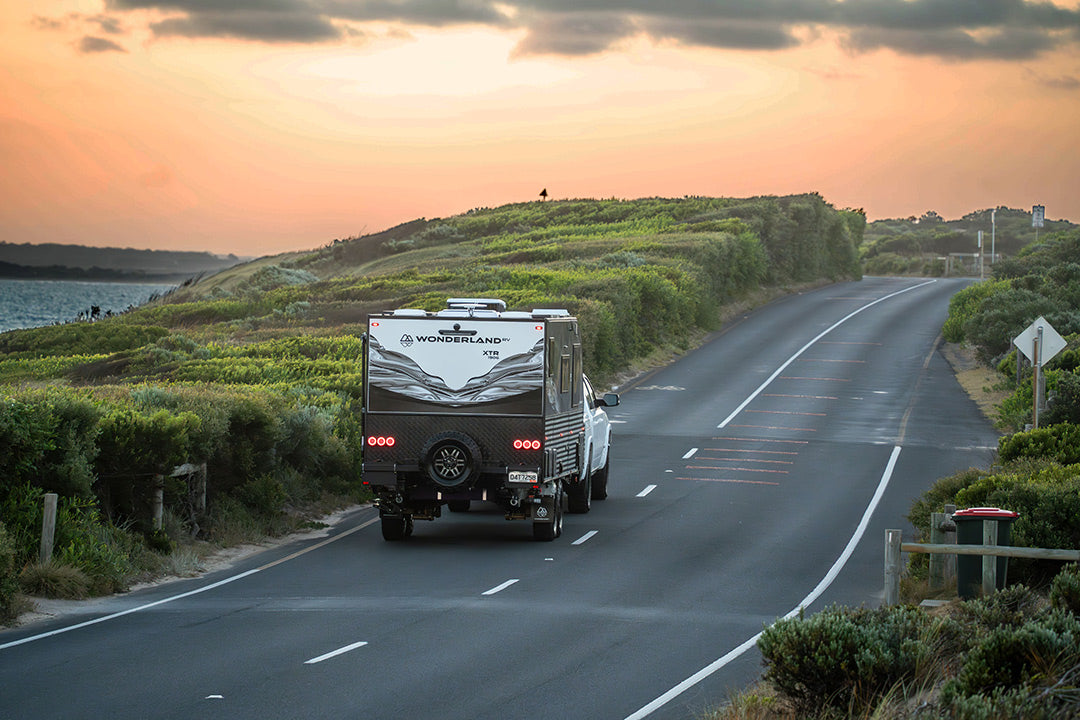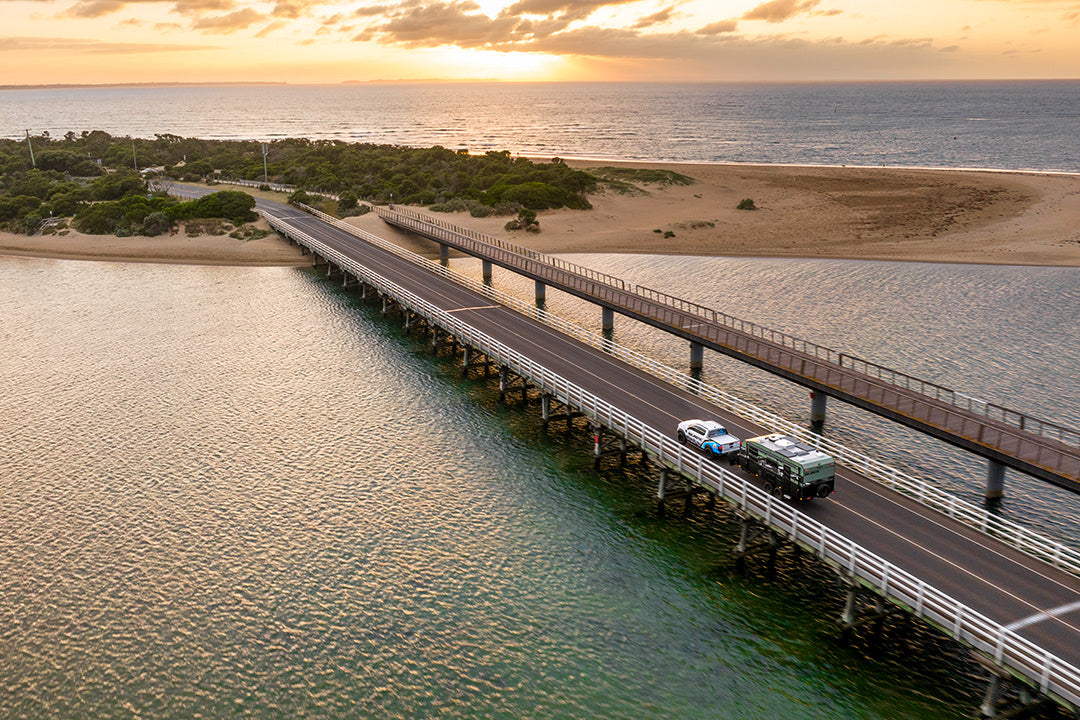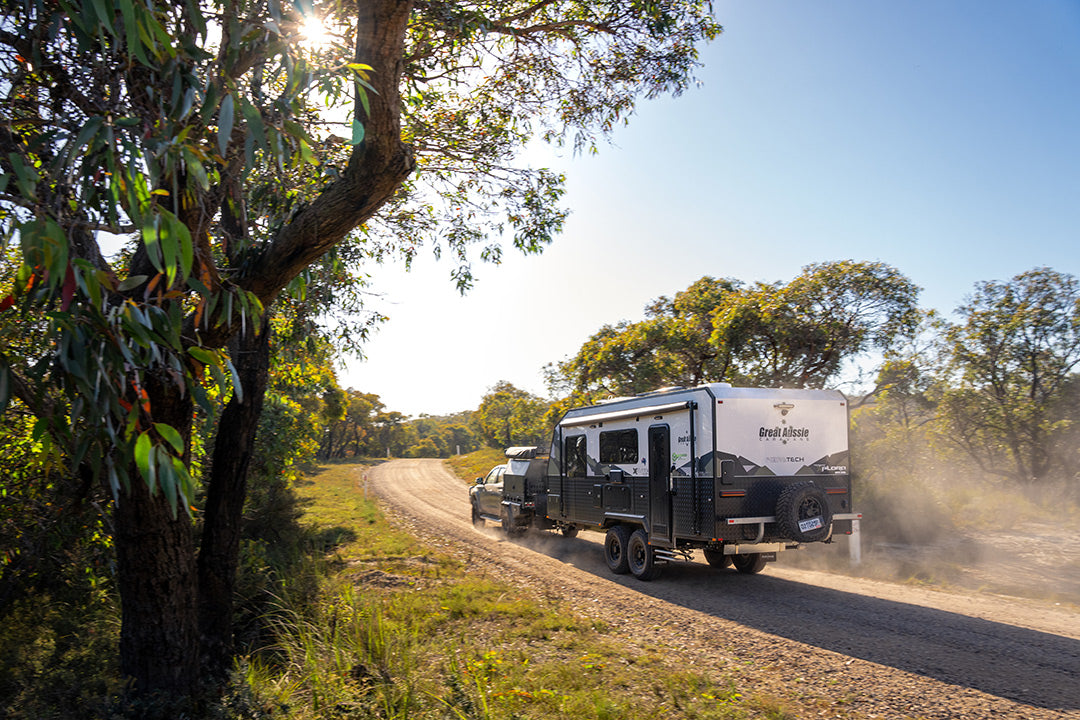Review: Cub C16 Caravan

I thought about starting this review with ‘I told you so’ because I truly feel caravan makers have been slowly, and unwisely, turning their backs on small, nimble and simple caravans for too long. In fairness, in the past few years a plethora of hybrids have entered the market, predominantly imports which are hard for our local builders to compete with on cost. But what if you wanted a locally built, quality caravan of small proportions? You would be wise to look towards Goldstream's excellent efforts and the semi-imported Vision range the team here so love but from there, the pickings get slim. Which gives Cub, one of the leading camper trailer makers with a strong 50-year history, an opening to take the slack.
WHO IS CUB CAMPERS?
Working across the brands that our parent company Emprise owns has made me lucky enough to sample a number of Cub Campers for sister masthead, Camper Australia. Over the past five years, I’ve been to Cape York with a Frontier, travelled through the Daintree with an Escape and I’ve been part of the judging panel at Camper Trailer of the Year where the Drifter II took out Best Build Quality in 2021. So, I’ve sampled the product a lot and maybe that's why I got the call to go look at the team's first-ever, real caravan.
Cub was founded in 1968 by father and son duo JK and Roger Fagan. Since then, some 20,000 campers have rolled out of the North Rocks, NSW factory. Most recently, the team has seen success with forward and twin-folding campers after pioneering rear fold models.
All major components like the chassis, body panels, canvas and as much of the componentry as possible are made in Australia. A few examples in the C16 are the use of Blue Scope steel for the chassis, Enduro X suspension and REDARC for power systems leading to all Cub trailers proudly wearing the Australian-made and owned logo.
WHAT IS THE CUB C16 CARAVAN?
There was once a hard-walled pop-top that garnered some interest but is no longer supported; this is the first real caravan from Cub. At a touch under 3m at ride height and about 2.2m wide with a 700kg payload, it is what I would call a mid-size which has appeal in towing efficiency, ease of backing and tracking behind a typical car but it is still roomy enough for a big bed (2.1 x 1.6m and 135mm thick) and has just about enough headroom for a giant like me with 1.9m floor to ceiling.

The internal length is where the C16 gets its name with 16 feet or 4.8m of floor from front to back. The layout is what I would suggest is the best for the space with a north-south bed tucked from wall to wall up front, a pair of bench seats, each with a fold-away table midships and what is one of the best ensuites I’ve seen tucked away in the rear, opposite the entrance.
The internal width is a touch over 2m with the sides of the 1.6m Slumberrest mattress filled with usable storage pockets. The bedhead has some overhead storage as well as robes, while at the foot of the bed are some drawers for shoes or whatnot. One thing the C16 is not short on is storage, a common issue with smaller caravans.
LIVING IN LUXURY INSIDE THE C16
As well as expecting the C16 to be robust and well finished, I expected it to be utilitarian and basic. I could not have been more wrong. One look through the oversized windows and it's instantly evident the C16 is targeted at people looking for the better side of life.
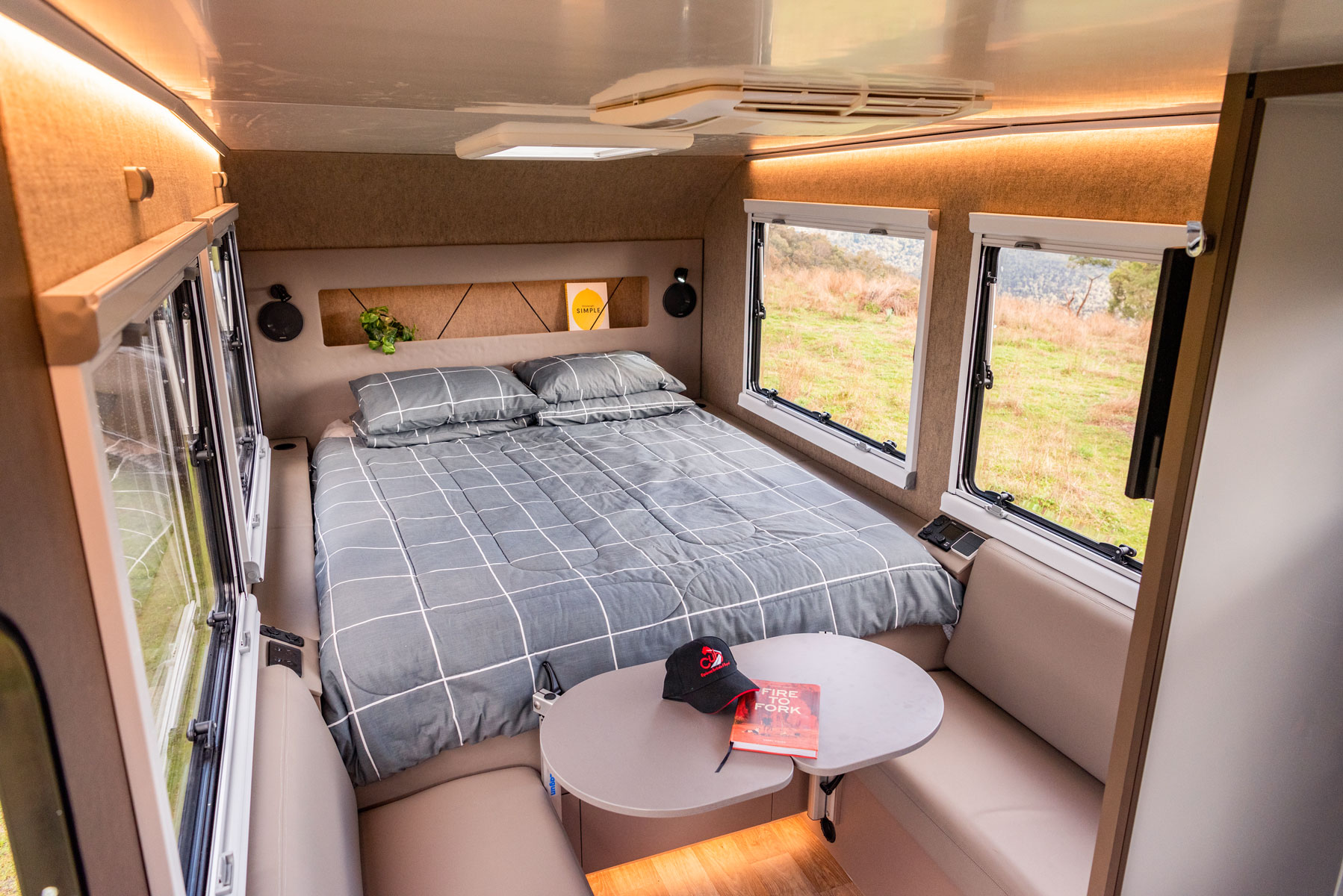
The internal walls are carpeted in a soft tan, and the floor is laminated with hardwearing fake wood, the seats are wrapped in a similar tone to the walls, but you need to step in to see the star of the show, the ensuite.
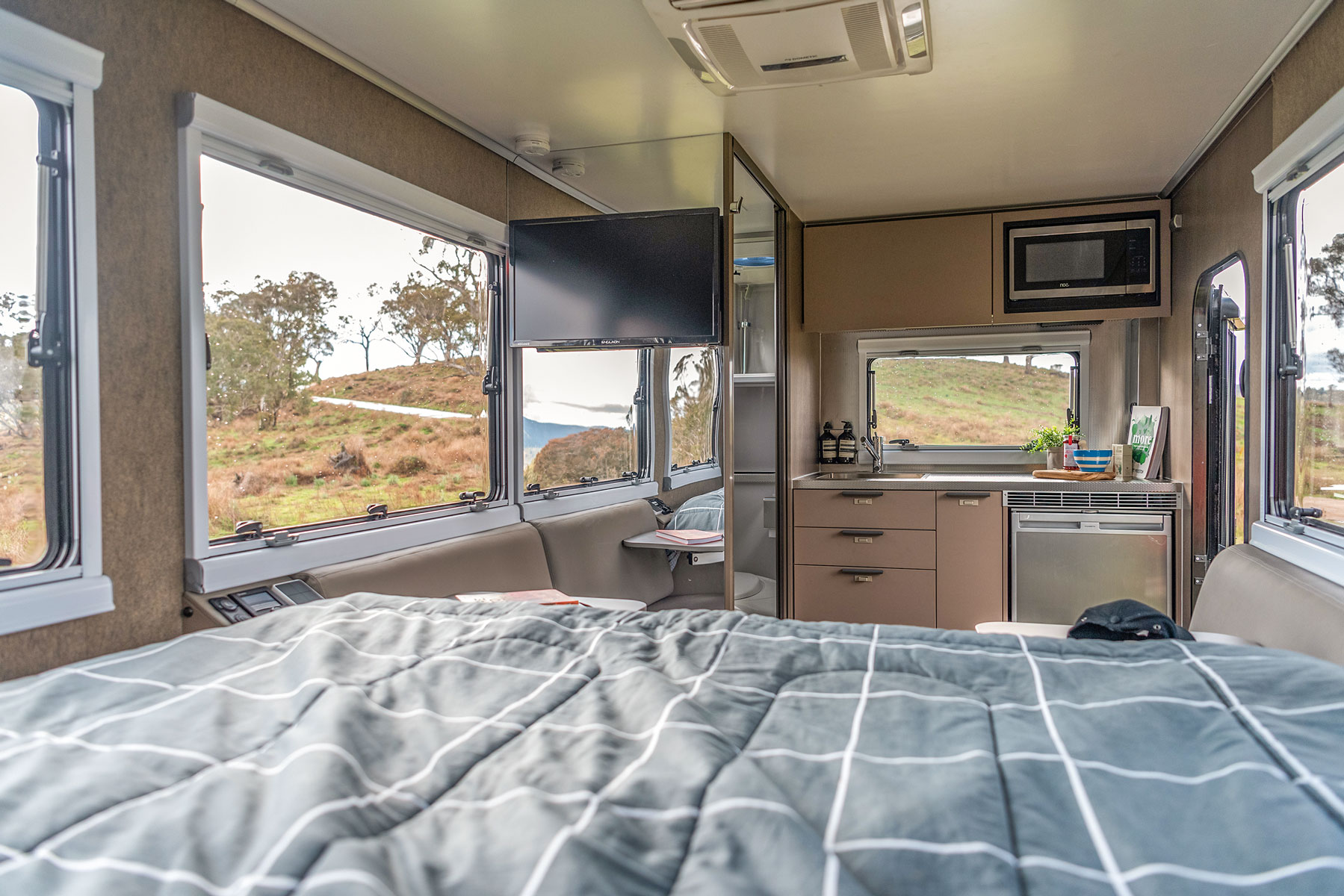
For hotter days there is an Ibis4 air-conditioning unit centrally located and under the far side lounge seat is a Truma Combi-D6 diesel water and space heater which will quickly take the edge off on cool mornings as well as heat the up-to 200L of fresh water quickly.

It’s not often I spend as much time as I did admiring the shower and toilet but a few subtle details had me wondering why other manufacturers hadn't thought of the same (I suspect they will after seeing this). There are folded stainless steel liquid soap bottle holders in both the shower and by the sink in the main room. There is a deep stainless-steel sink above the toilet that looks perfect for emergency clothes washing and the floor has a wood-like, removable, planking that not only makes it feel like you're showering in a tropical getaway but helps drainage and is anti-slip. It looks fantastic and is wonderfully practical.
Speaking of practical, although the shower shares the same room as the toilet, there is good separation between the two and the space to the sides of the Thetford toilet just passes the elbow test; it is a big ensuite for a 16-footer.
HOW THE CUB C16 IS BUILT
What else is unique and unexpected about the C16 is the construction methodology. Cub campers typically feature alloy frames to support hardwearing and light aluminium panels but, with the size of the C16 came the opportunity to move to a full composite body, a process perfected by Zone RV some 10 years ago.
Anyone who reads my work knows I am a proponent of this way of building. The thermal and sound deadening properties of thick, composite panels are a massive benefit, but they are also easy to work with and require low levels of labour leading to cost savings. Another benefit is the ability to router cut in all holes and access points into the sheets as well as the ability to curve them over roofs with the simple addition of a few relief cuts on the inside of the bend. Cub does this with the roof panel a single piece leading from the front of the van to under the rear. It should also be noted that the roof is not flat, it has a central peak to reduce any chance of water pooling, an issue some flat-roofed composite panelled vans had in the early days of this build method.

The skins of the 30mm thick panels are alloy, not fibreglass as often seen. I was surprised by this as I like that fibreglass is easily patch-repairable where I suspect a decent knock to the wall of the C16 would require a full panel replacement (this is not as hard as you might expect).
The chassis is all Blue Scope steel measuring in at 150x50x3mm and is hot dip galvanized with added stone protection paint on leading and exposed surfaces, while the three underbody tanks are polyethylene with two for fresh water and a third 100L grey tank standard.
WHAT SUSPENSION THE C16 RIDES ON
The C16 rides on AL-KO Enduro X independent trailing arm suspension. It differs from most trailing arm suspension designs by using a clamshell design. It features two pressed pieces of sheet metal that have been formed into two halves of a clamshell that are then welded together into a rigid box structure. There are also ribs pressed into the metal for more strength.
I couldn’t suggest it is tougher than more typically seen welded box-section steel arms - for that we’d need some finite analysis and stress-testing - but what I can suggest is that it will be light, and it will be strong. If you look under most SUVs and 4WD utes, you’ll see the same construction method used for lower control arms due to its strength-to-weight benefits.

In terms of articulation, Enduro X has 140mm of wheel travel and in single axle arrangements like under the Cub C16, is rated to 2500kg Gross Trailer Mass and in twin axles, it’s 4100kg.
I like that the stub axles are bolt on and they’ll accept either drum or disc brakes and will support Tow Assist, AL-KO’s new trailer safety system that incorporates ESC and ABS which is fitted to this van, which you can read about in John Hughes’ report in issue 627 and online.
Attached to the stub axles are 12” drum brakes with a good-looking set of alloy wheels wrapped in BFG KO2 MT tyres which, when deflated, will be hard to beat for off-road grip. Speaking of grip, we needed it all in what was a challenging tow.
NEW RANGER SPORT V6
The eagle-eyed among you will notice we had a 2022 Ranger Sport V6 to haul the 2100kg Cub up to our shoot. It was our first drive of the 10-speed, 3.0L V6 Ranger and we were truly excited to see how it stacked up.
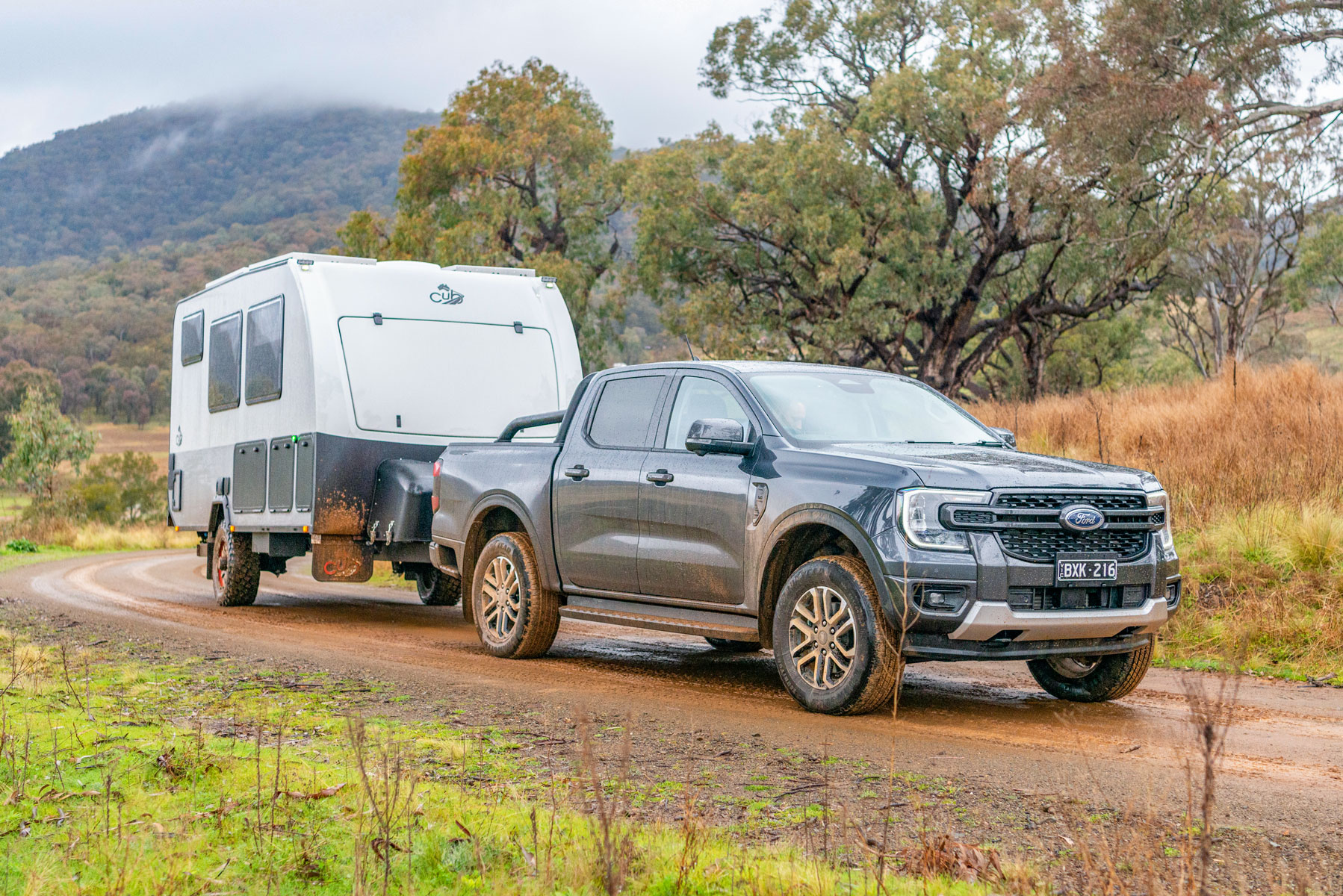
Being a ground-up new model, it has a big challenge to step up quality, performance and safety in the competitive double-cab ute market and it does. I’ll get you the full rundown in the next issue but for the C16, here are some notes.
TOWING THE CUB C16
The AL-KO Enduro X was almost flawless. Following on from a severe rain event that had us reschedule our shoot, I was tasked with returning the C16 to Sydney from Capertee, NSW. This meant a long haul up and over the Blue Mountains in what could be described as very, very windy conditions. I’ve towed enough to know what to look for so held my pace significantly slower than normal and watched the trees for gusts and my mirrors for any signs the van was starting to lose balance and by in large it was a good tow.
In the tighter, twisty and dirt roads of Turon Gates, where we shot this review, Enduro X was perfect. Through deep washouts, it took the harsh bumps well never bouncing the van. Tracking along the uneven ground also felt good, I never felt any unease or had the ESC or ABS kick in on the Tow Assist package that comes standard on the C16.
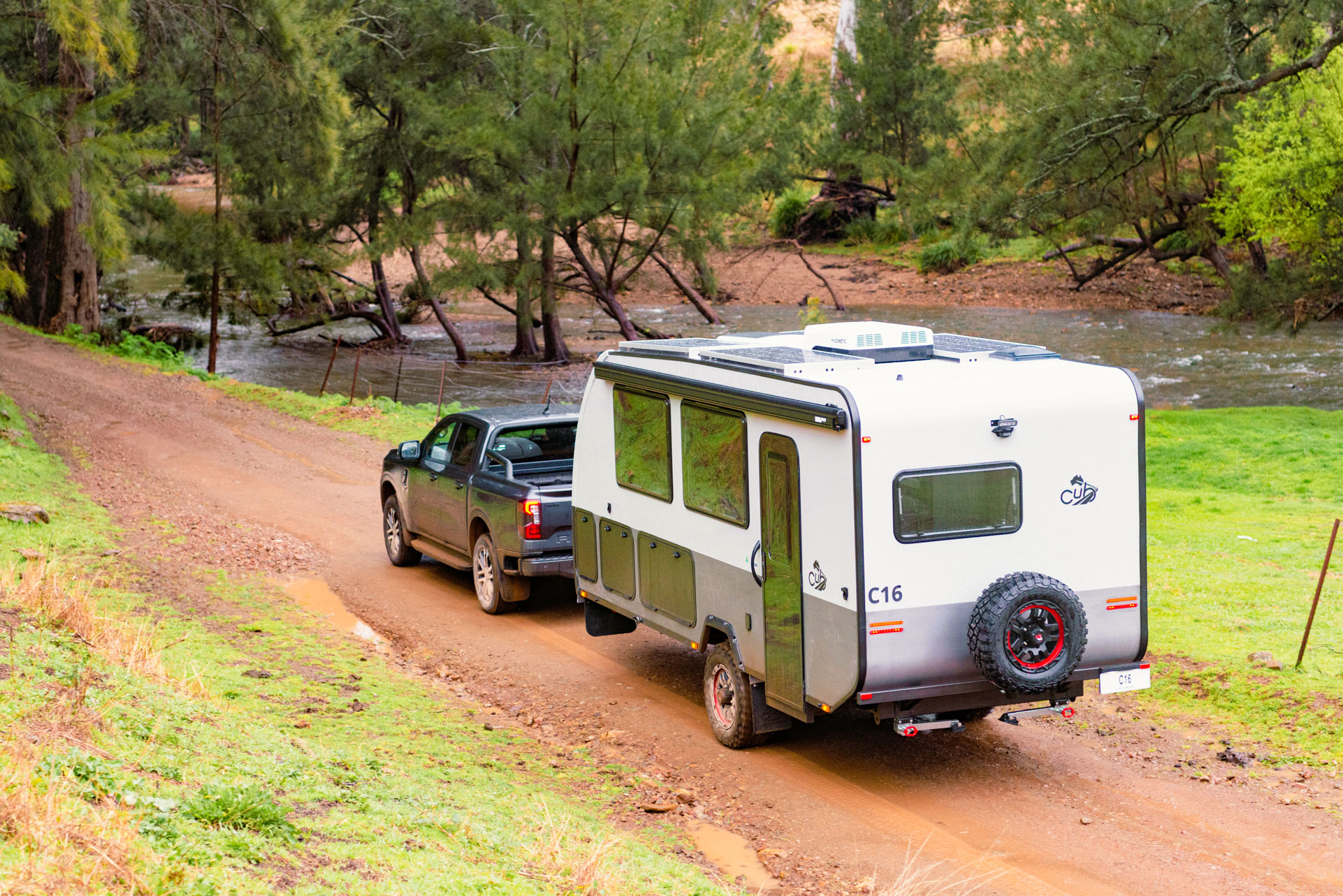
Trying our hand at a river crossing that had me wince as a bow-wave rose to the 800mm wading depth of the Ranger. It was again great with no water making it inside the doorstep or any of the double sealed hatches on the C16 and we knew how deep we had been as the water had washed the dust off from just above the wheel arches.
THE POWER OF REDARC
Two issues ago, I mentioned that it was an unexpected delight to see REDARC powering the seriously impressive Evernew RTX35 and that it was the first van I’d seen powered that way. Well, good things come in two as this is the second inside of two months with the proud South Australians’ gear.
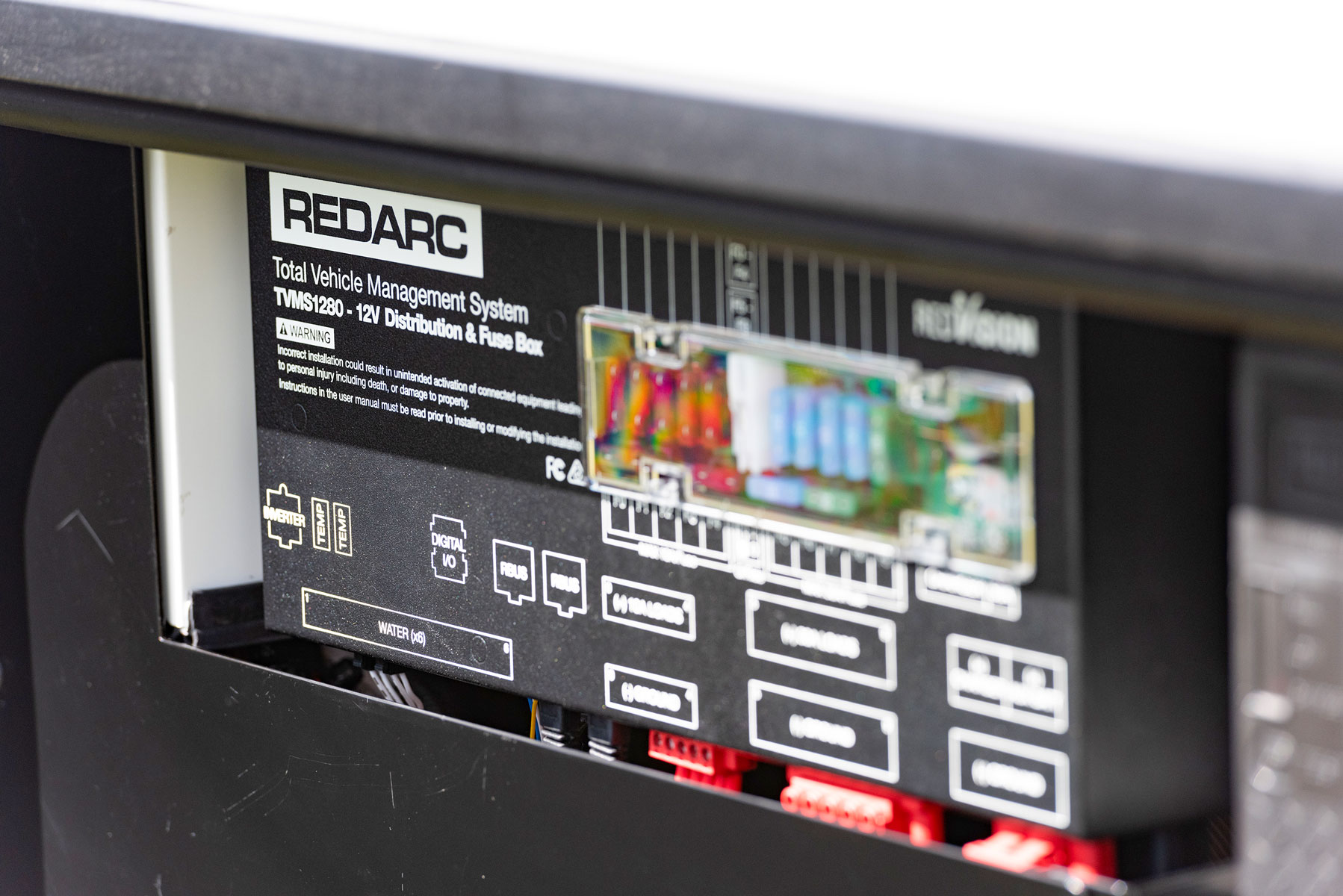
It features 400Ah of lithium split between two batteries, a Manager 30 air-conditioner charger and a BCDC1240 that takes power from the Anderson plug and solar. Up top, there is a combined 720 watts of solar that on a typical day should pump in 40Ah or plenty in other words. The two chargers feed data into a Total Vehicle Management System, or TVMS, which is also linked to water tank sensors to make the display your one-stop-shop for knowing your state of charge, where your power is going and the levels in your three tanks.
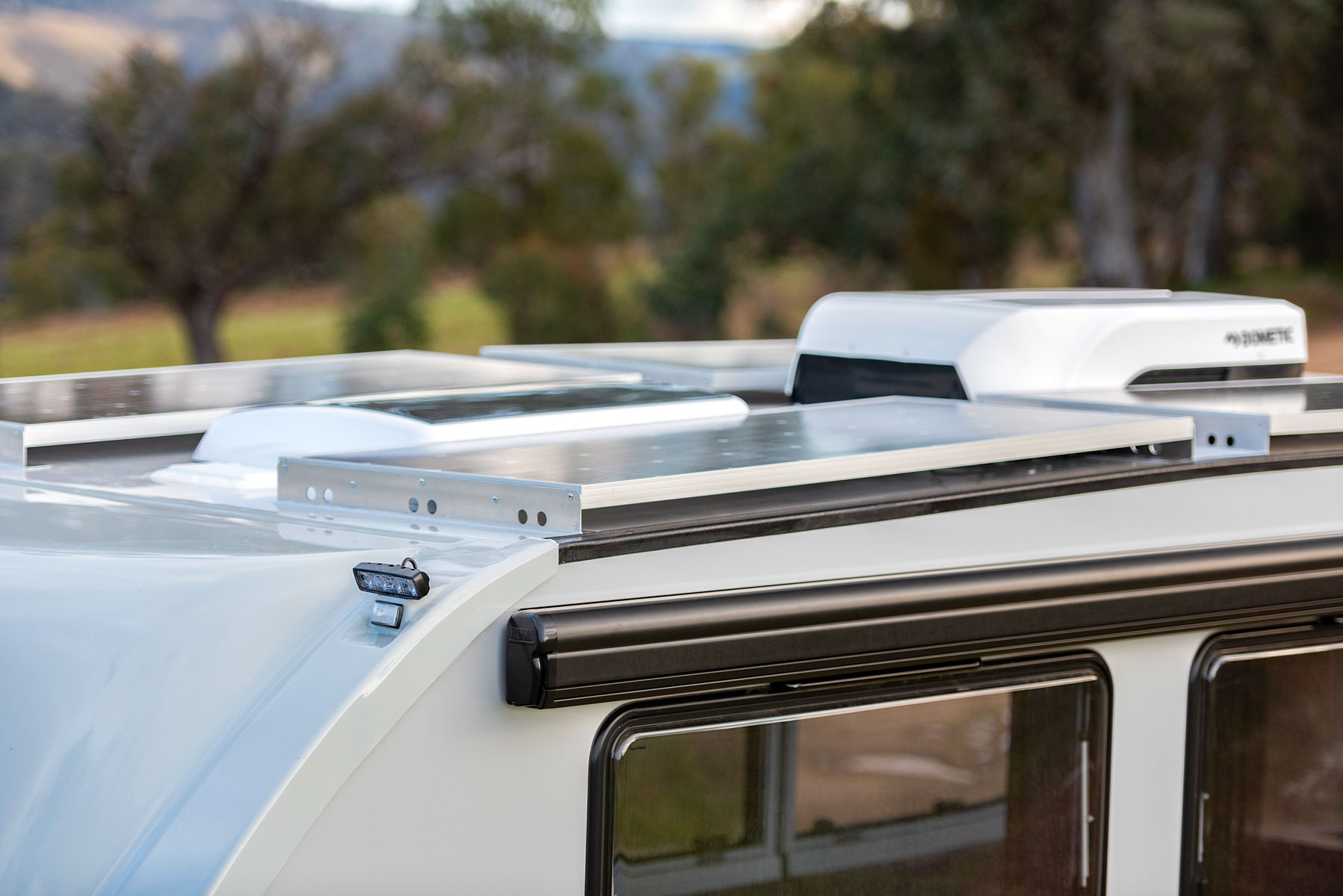
TVMS is insanely powerful. It has the capacity to divert power to where it is being used while also charging the batteries while prioritising free-solar power. It also has inputs for a range of sensors like fridge temperature as well as the temperature inside the van so you can monitor if your fridge is effective as well as know how warm it might be inside the van as you head into camp and on this, I suggest the C16 misses one opportunity.
There was no inverter in the C16 which baffled me a bit as the 400A of lithium and 720W of solar will never be challenged by the LED lighting or fridges. To me, there should be one that is connected to the Dometic Ibis4 air-conditioner so that should you see the temperature high inside the van, you could fire up the AC to take the heat off before pulling up at camp. I've passed on my feedback to the team and they’ve mentioned it is an easy retrofittable option on any C16.

OUTSIDE LIVING WITH THE CUB C16
This is my mantra although I do appreciate an internal lounge when the bugs come to suck my blood. Typically, you’ll find me only sleeping and changing inside a van or camper, I’ll even prefer the outside shower partly as I tend not to fit in most showers but also as I like to keep things clean and tidy. For the rest of my camping time, I’ll be out and about, lazy by a fire or relaxing with a book. One thing I rarely do is cook inside so the kitchen layout in the C16 works for me.
Inside the van is a 110L Dometic compressor fridge and some bench space with a deep sink, that's it. You should option on an inverter (I would, the battery can take it) and add on a coffee machine, kettle, induction cooker and what not but otherwise, as standard, the C16’s cooking is done outside through a three-burner Dometic stove on the excellent and sturdy slideout kitchen which is permanently plumbed for hot and cold water.
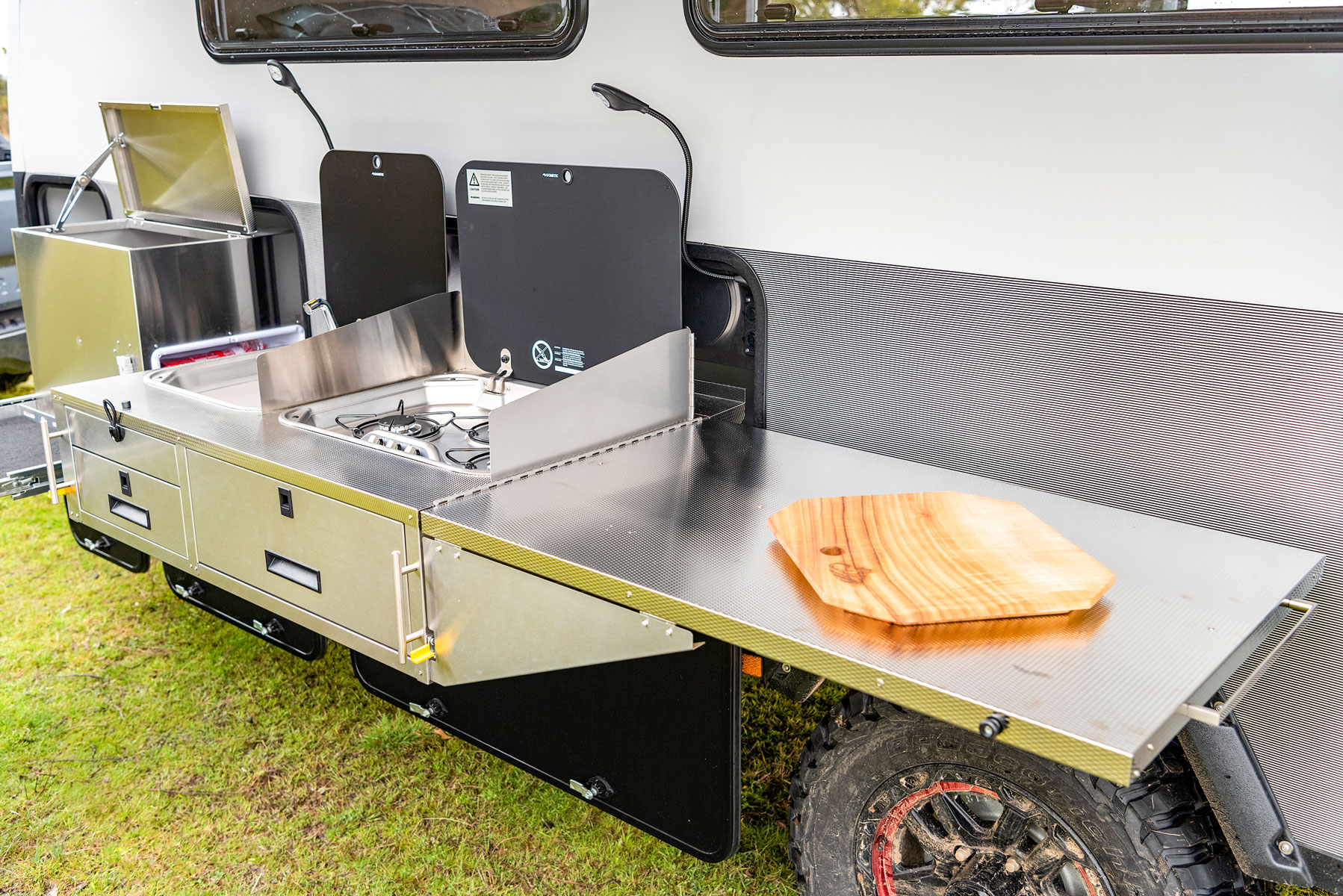
Beside the kitchen is a large slide that has the capability to house a CFX95 portable fridge/freezer bringing the total cool stores to 205L. On the same slide is a small locker to its rear that will be perfect for heavy items like pots and pans.
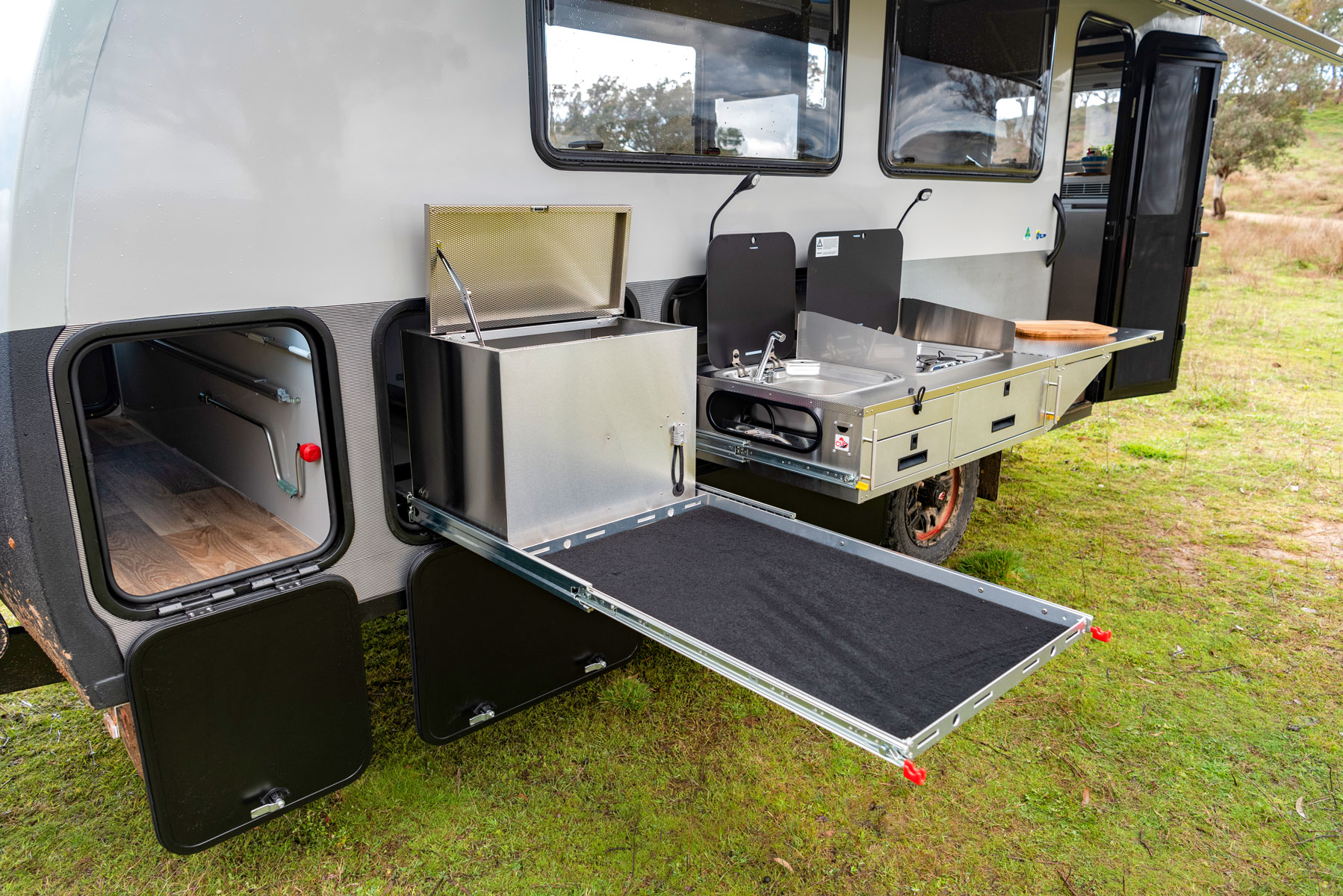
The height of the kitchen suited me well with the benchtop around 120cm off the ground. It is entirely made of stainless steel (locally sourced) with a diamond finish to the tops. This pattern hides scratches well but is still easy to clean.
In front of the fridge slide is a full-length tunnel boot which I thought was the end of the external storage but boy was I wrong.
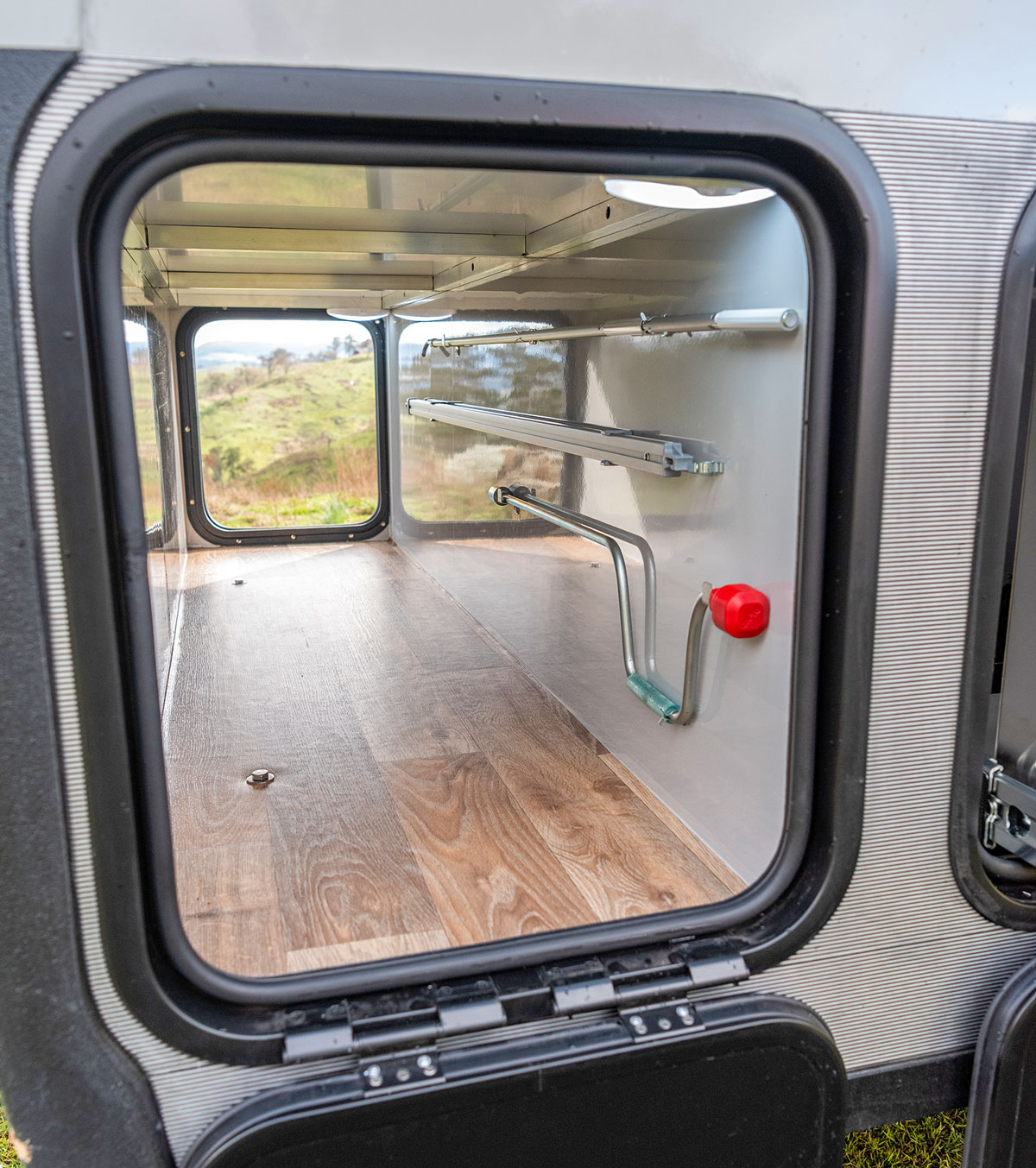
Around the front of the van is a simple but effective cover for a pair of 4.5kg gas bottles that feed only the kitchen and a pair of jerry-can holders that could be used to refill the tow-tug or to add 40L to the 200L freshwater capacity. Above them is a front boot locker that has been well thought out with sensor light, carpet lining and tiedown points. It screams as the obvious place for camp chairs and other lightweight items.
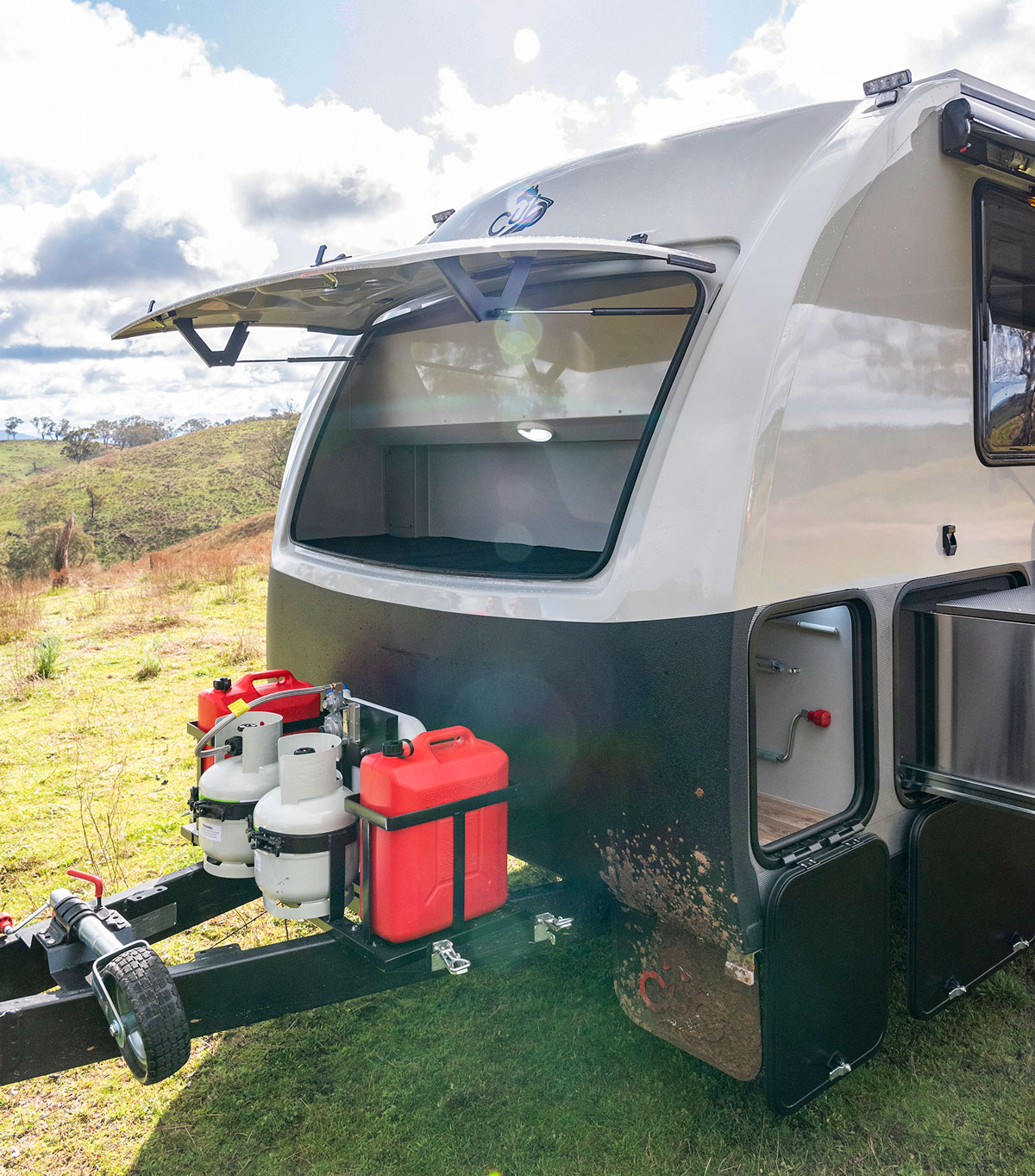
IS THE C16 GOOD VALUE FOR MONEY?
Now before you go spit your coffee or tipple out, yes $130,000 is a lot of money for a caravan and yes, it is especially a lot for a 16-foot one. But I challenge you to go see the C16 at your next caravan and camping show as I suspect you’ll share my sentiment that it has an impeccable build quality, gorgeous internal fit out and the power and water systems to suggest it’s probably not a bad deal. This is a long-term van, not one to depreciate heavily over a few summers but one to hold onto for a decade or two of reliable service in which time, I expect you’ll lose little on its resale. One look at what Cub’s campers sell for used and you’ll see they hold their value exceptionally well.

THE BOTTOM LINE
I’m seriously impressed with what Cub has done. It has carried over the robust and impeccable build I’ve seen in its campers into the C16 while also taking a modern approach to the build methodology while adding immense luxury. The C16 goes down as a van I would buy which I rarely say publicly that's how impressed I am.
CUB CAMPERS C16 Pros and Cons
Pros
- Light-filled paradise inside
- Excellent build quality
- Best ensuite I’ve seen
Cons
- Needs an inverter
- An external step would be nice
CUB CAMPERS C16 SPECFICIATIONS
Weights and Measures
| Overall length | 7.45m (24ft 4in) |
| Internal body length | 4.8m (16ft) |
| External body width | 2.23m (7ft 2in) |
| Travel height | 2.92m (9ft 6in) |
| Internal height | 1.95m (6ft 5in) |
| Tare | 2000kg |
| ATM | 2700kg |
| Payload | 700kg |
| Ball weight | 140kg |
External
| Body | 30mm Composite panels |
| Chassis | 150x50x3mm Blue Scope Steel |
| Suspension | AL-KO Enduro X |
| Brakes | Electric 30cm (12in) |
| Wheels | 265/75/R16 BFG KO2 MTs |
| Water | 200L fresh, 100L grey |
| Battery | 12V 400A lithium/30A & 40A charger |
| Solar | 720w |
| Air-conditioner | Dometic IBIS4 |
| Sway control | AL-KO Tow Assist |
Internal
| Fridge | Dometic 110L Compressor |
| Toilet | Thetford Cassette |
| Shower | Fully moulded fibreglass |
| Lighting | LED |
| Hot water | Truma Combi-D |
Cub C16 Caravan Price as Tested: $129,990
Supplied by Cub Campers
THE NEXT STEP
If you need help choosing your first RV or are considering upgrading your existing one, check out Cub Campers available on TradeRVs today.
The sellers will be happy to help and answer any inquiries you may have about the products advertised for sale.




